Contents
Pear Kupava belongs to the category of crop species that are able to fully develop and produce crops in regions with difficult climatic conditions. Also, the variety is valued for its high useful properties and excellent taste of the fruit. But in order for this pear to maintain a high life potential for as long as possible, it is necessary to study the features of its planting and further care.
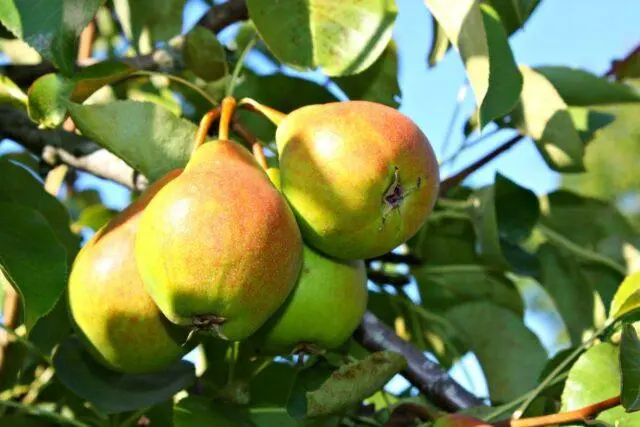
The Kupava variety is able to adapt to any climatic conditions.
History of breeding
Work on the breeding of this variety was carried out by employees of the Research Institute. Lisavenko in Barnaul. The purpose of the creation was to obtain a pear that can consistently bear fruit in the northern regions of the country and have a high level of endurance. For this, the Tema variety was pollinated with the pollen of Clapp’s Favorite. One of the obtained seedlings was selected as a result of selection. He managed not only to absorb the best qualities of his ancestors, but also to surpass them in certain characteristics.
The authors of the Kupava variety are breeders: I. A. Puchkin, I. P. Kalinina, E. P. Karataeva, M. I. Borisenko. It was officially registered in 1971 and entered into the State Register after successful variety trials in 2000.
Description of the pear variety Kupava with a photo
The appearance of the tree and fruits of the Kupava pear has some features. Knowing them, you can accurately determine the belonging of the variety. Therefore, you should study the main differences in order to avoid mistakes when buying.
Tree
Pear Kupava is a medium-sized tree, the height of which reaches 4 m. The crown is rounded, densely leafy. The branches are numerous, departing from the main conductor at an acute angle. The bark is gray-brown, flaky. Young shoots of pear Kupava are thin, upright, yellow-brown.
The leaves are medium in size with a shiny surface, concave in the center. They are dark green and shiny. The plates of the Kupava pear are rounded, on thin elongated petioles. The variety mainly forms fruits on complex and simple annulus, 3-5 cm long.
The flowers of the Kupava variety are medium in size, up to 2,5 cm in diameter. They consist of five oval petals, the pistil and stamens are located on the same level. The buds are collected in racemose inflorescences of 3-5 pieces. Flowering in the Kupava variety occurs in early May and lasts up to two weeks.
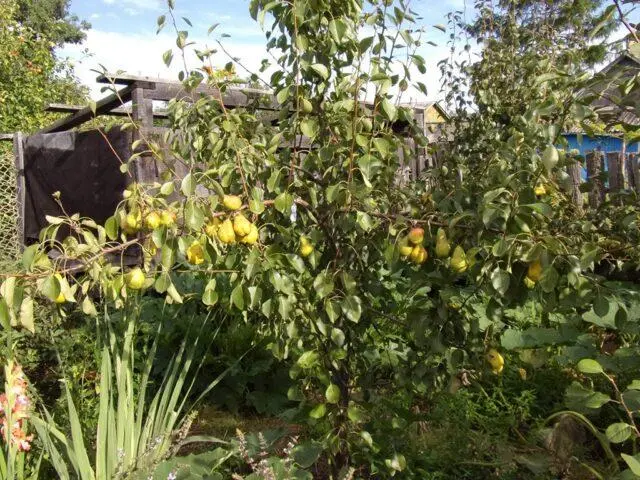
The pear has an average growth rate, the annual growth is about 40 cm.
Fruit
In Kupava, the fruits are smaller than average in size, strongly tuberous, weighing 88-100 g. They are pear-shaped, slightly sloping, with a sharp run to the top. The skin is thin, oily, shiny, not felt when eaten. When ripe, Kupava pears acquire a golden yellow hue with a bright red blush, which occupies a third of the entire surface. Subcutaneous points are greenish, weakly expressed, small.
The saucer of Kupava’s pears is wide, furrowed. The funnel is not expressed. Bulb-shaped heart, medium size. Seed chambers of the closed type. The pulp is white, moderately juicy, dense. Seeds are small, ovoid, brown.

Kupava pears are suitable for fresh consumption and processing.
Characteristic of the variety
You can determine the productivity of the Kupava pear if you familiarize yourself with its characteristics. This will allow you to compare the variety with other types of crops and identify its strengths and weaknesses.
Palatability
Kupava fruits have a sweet and sour taste with a moderate aroma. The sugar content in them reaches 11,5%, and the mass fraction of ascorbic acid is 11 mg per 100 g of product. The tasting score of the Kupava variety is 4,2 points out of a possible five.
Terms of maturation
The fruiting of the variety is stretched. The first fruits ripen in late August, early September. The collection is recommended to be carried out in several stages over two weeks.
Productivity
The Kupava variety begins to bear fruit 4-5 years after planting. With proper care, the pear yields annually. Its volume is 35-40 kg.
Frost resistance of pear Kupava
This variety is highly resistant to low temperatures. Kupava withstands frosts down to -30 °C. And even if it freezes in winter, it has the ability to quickly recover within one season.
Kupava pear pollinators
Kupava belongs to the category of self-fertile varieties. Therefore, this pear does not need a close planting of pollinating trees. This guarantees fruit set even under adverse weather conditions.
Growing regions
Pear Kupava is recommended for cultivation in the West Siberian region. But, judging by the reviews of gardeners, this variety shows good performance in the central regions.
Disease resistance
Pear Kupava has a high natural immunity, therefore it is not very susceptible to common fungal diseases. But the tree is subject to attack by the pear codling moth. Therefore, it is necessary to regularly inspect the crown, apply insecticides as a preventive measure and when the first signs of damage appear.
Advantages and disadvantages
The Kupava pear variety has many advantages, thanks to which it has become popular among gardeners. But it also has certain disadvantages that must be considered when choosing.
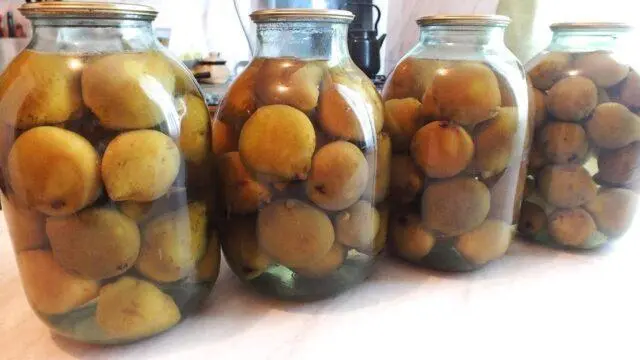
Pear Kupava – one of the best varieties for making compote
Main advantages:
- good presentation;
- balanced taste;
- frost resistance;
- low susceptibility to fungal diseases;
- fruiting is stable;
- does not require pollinators.
Disadvantages:
- suffers from pear codling moth;
- the surface of the fruit is bumpy;
- demanding on the composition of the soil.
Rules of landing
It is recommended to plant the Kupava pear in a permanent place in early spring before the start of active vegetation. For the variety, it is recommended to choose a sunny open place, protected from cold gusts of wind. At the same time, it is important that the groundwater level on the site is at least 2,5 m.
This variety prefers loamy soil or black soil with a neutral level of acidity. Two weeks before the procedure, it is necessary to prepare a planting hole 80 by 80 cm in size. Pour a 10 cm thick drainage layer on the bottom of it, and fill the rest of the space with a nutrient soil mixture consisting of turf, sand, humus and leafy soil in a ratio of 2: 1: 1: one. Also, in addition to the well, you need to add 1 g of superphosphate and 40 g of potassium sulfide, and then mix the fertilizer thoroughly with the ground.
Procedure:
- Make a slight rise in the center of the hole.
- Install a wooden support 1-1,3 m high nearby.
- Put a seedling on a raised platform, straighten the roots.
- Water it generously.
- Sprinkle the roots with earth and fill in all the voids.
- Tamp the soil at the base of the tree.
- Tie the pear to the support with soft twine.
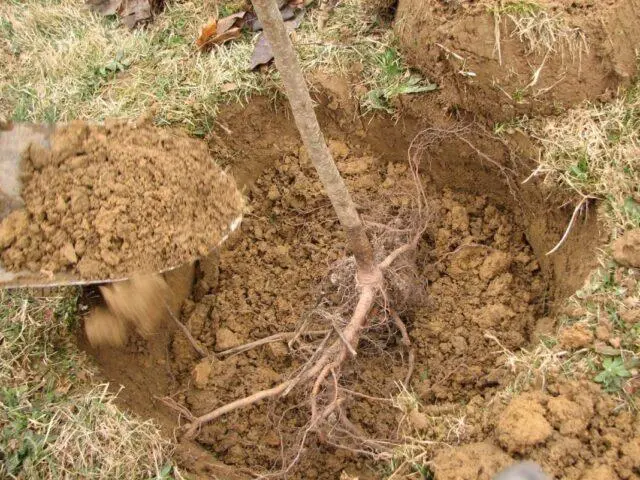
After planting, the root neck of the seedling should be at the level of the soil surface.
Further Care
Growing pear Kupava does not cause difficulties even for beginner gardeners. Since caring for a tree involves the implementation of standard care measures.
This pear tree should be watered as needed. Immediately after planting, this should be done once a week at the rate of 20-30 liters of water for each seedling. After a month, moisturizing is recommended to be reduced to once every two weeks. An adult tree needs to be watered only during a long drought. Moisturizing is especially important for it during flowering and fruit set.
Pear Kupava must be fed three times per season. The first time to fertilize is recommended in early spring at the beginning of the growing season. At this time, the actual use of urea at the rate of 30-60 g per 10 liters of water, depending on the age of the pear. The second dressing is recommended after flowering. For her, you can use chicken manure 1:15 and mullein 1:10. And the third time you need to fertilize the pear during the formation of fruits. During this period, it is recommended to add 40-80 g of superphosphate and 25-50 g of potassium sulfide per 10 liters of water.
Throughout the entire growing season, it is necessary to remove growing weeds in the root circle and loosen the soil surface. This will keep the nutrients and air access to the roots.
Pear Kupava is able to independently form the correct shape of the crown. But, in order to stimulate its development, it is necessary immediately after planting to shorten the main conductor to a height of 50-60 cm. In the future, it is enough just to pinch young shoots in summer and periodically clean the crown from broken, damaged and thickening branches.
A seedling after planting for three years needs shelter for the winter. Therefore, in late autumn, it is necessary to lay a layer of humus 5 cm thick in the root circle, and wrap the crown several times with agrofiber.
Collection and storage
It is recommended to harvest Kupava at the stage of technical maturity. This will keep the fruit fresh for as long as possible. To do this, they need to be cut with scissors from the branches and placed in wooden or cardboard boxes, lining the layers with paper.
Recommended storage conditions: temperature +3-4 °С and air humidity at the level of 60%.
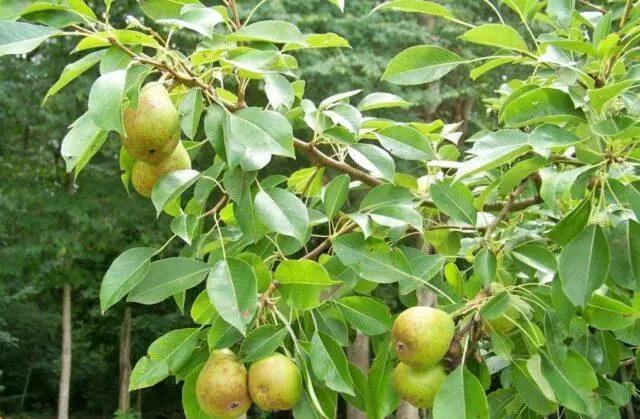
Fruits retain consumer properties when kept cool for up to four weeks
Conclusion
The Kupava pear is a variety with a high life potential, which allows it not only to develop, but also to bear fruit regularly in regions with risky farming. But in order to maintain a high level of tree hardiness, it is necessary to provide the right care, taking into account the requirements of the culture.










